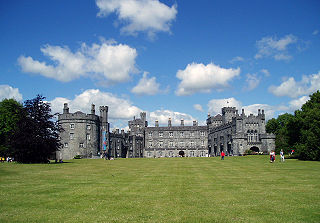
Kilkenny Castle is a castle in Kilkenny, Ireland, built in 1260 to control a fording-point of the River Nore and the junction of several routeways. It was a symbol of Norman occupation, and in its original 13th-century condition, it would have formed an important element of the town's defences with four large circular corner towers and a massive ditch, part of which can still be seen today on the Parade.
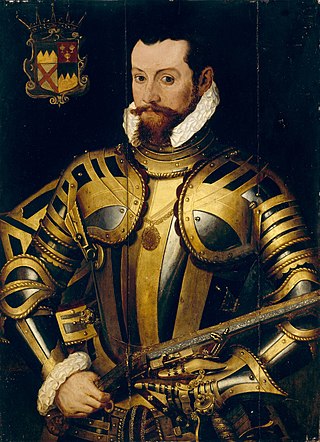
Thomas Butler, 10th Earl of Ormond and 3rd Earl of OssoryPC (Ire), was an influential courtier in London at the court of Elizabeth I. He was Lord Treasurer of Ireland from 1559 to his death. He fought for the crown in the Rough Wooing, the Desmond Rebellions, and Tyrone's Rebellion. He fought his rival, Gerald FitzGerald, 14th Earl of Desmond in the Battle of Affane in 1565.
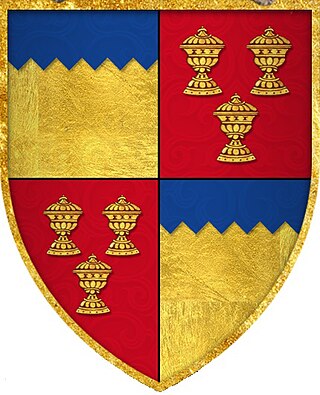
Piers Butler, 8th Earl of Ormond, 1st Earl of Ossory also known as Red Piers, was from the Polestown branch of the Butler family of Ireland. In the succession crisis at the death of Thomas Butler, 7th Earl of Ormond he succeeded to the earldom as heir male, but lost the title in 1528 to Thomas Boleyn. He regained it after Boleyn's death in 1538.

Elizabeth Stanhope, Countess of Chesterfield was an Irish-born beauty. She was a courtier after the Restoration at the court of Charles II of England at Whitehall. She was the second wife of Philip Stanhope, 2nd Earl of Chesterfield.
Kilkenny City was a constituency represented in the Irish House of Commons until 1800.
Walter Butler (1703–1783), also known as Walter Butler of Kilcash, and Walter Butler of Garryricken, was the de jure16th Earl of Ormond and 9th Earl of Ossory. He did not assume these titles, as he thought them forfeit as a result of the attainder of the 2nd Duke of Ormonde. In the peerage of Ireland, the titles were successfully claimed in 1791 by his son John, the 17th Earl.
Sir Walter Butler, 11th Earl of Ormond and 4th Earl of Ossory (1559–1633), succeeded his uncle Black Tom, the 10th earl, in 1614. He was called "Walter of the Beads" because he was a devout Catholic, whereas his uncle had been a Protestant. King James I intervened and awarded most of the inheritance to his uncle's Protestant daughter Elizabeth. Ormond contested the King's decision and was for that insolence detained in the Fleet Prison from 1619 until 1625 when he submitted to the King's ruling. He then found a means to reunite the Ormond estate, by marrying his grandson James, who had been raised a Protestant, to Elizabeth's only daughter.

Rothe House is a late 16th-century merchant's townhouse complex located in the city of Kilkenny, Ireland. The complex was built by John Rothe Fitz-Piers between 1594–1610 and is made up of three houses, three enclosed courtyards, and a large reconstructed garden with orchard. As a museum, it is accessible to the public.

The Diocese of Ossory is a Latin Church diocese of the Catholic Church in eastern Ireland. It is one of three suffragan dioceses in the ecclesiastical province of the Metropolitan Archbishop of Dublin. Currently, it is led by Niall Coll who was appointed on 28 October 2022 and will be ordained bishop on 22 January 2023.

Freshford is a village and former town in the barony of Crannagh, County Kilkenny, Ireland. It is 13 km north-west of Kilkenny city. The village is in a civil parish of the same name.
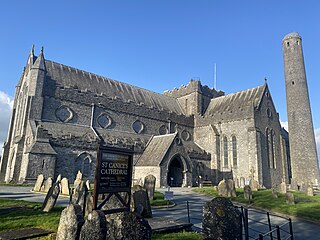
St Canice's Cathedral, also known as Kilkenny Cathedral, is a cathedral of the Church of Ireland in Kilkenny city, Ireland. It is in the ecclesiastical province of Dublin. Previously the cathedral of the Diocese of Ossory, it is now one of six cathedrals in the United Dioceses of Cashel and Ossory.
The Mayor of Kilkenny is an honorific title used by the head of Kilkenny Borough Council. The Council has jurisdiction throughout its administrative area which is the city of Kilkenny in the Republic of Ireland. The office was established in the 16th century and had significant powers. The office was all but abolished under the Local Government Act 2001. All that remains of the office, per section 11 of the Act is a symbolic role: "Subject to this Act, royal charters and letters patent relating to local authorities shall continue to apply for ceremonial and related purposes in accordance with local civic tradition but shall otherwise cease to have effect.". The Act goes on to state the chairman of the Council must be styled the Cathaoirleach and that "Any reference in any other enactment to the lord mayor, mayor, chairman, deputy lord mayor, deputy mayor or vice-chairman or cognate words shall, where the context so requires, be read as a reference to the Cathaoirleach or Leas-Chathaoirleach or other title standing for the time being.".
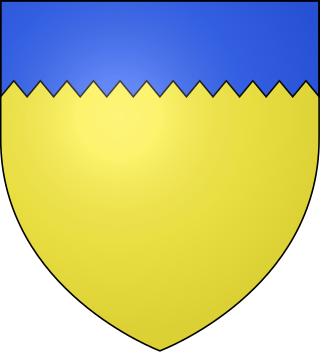
Butler is the name of a noble family whose members were, for several centuries, prominent in the administration of the Lordship of Ireland and the Kingdom of Ireland. They rose to their highest prominence as Dukes of Ormonde. The family has produced multiple titles such as Baron Cahir, Baron Dunboyne, Viscount Ikerrin, Viscount Galmoye, Viscount Mountgarret, Viscount Thurles, Earl of Carrick, Earl of Kilkenny, Earl of Ormond, Earl of Ossory, Marquess of Ormonde and Duke of Ormonde. Variant spellings of the name include le Boteler and le Botiller. The Butlers were descendants of Anglo-Norman lords who participated in the Norman invasion of Ireland in the 12th century. The surname has its origins in the hereditary office of "Butler (cup-bearer) of Ireland", originating with Theobald Walter, 1st Chief Butler of Ireland. The arms of later family members depicted three cups in recognition of their original office.
Sir John Everard was an Irish barrister, politician and judge. He was notable as the last Irish judge until the reign of James II to openly profess the Roman Catholic faith. His religious beliefs eventually led to his enforced resignation from the Bench in 1607.
Gerald Comerford (c.1558–1604), was an Irish barrister, judge and statesman of the late sixteenth and early seventeenth centuries. He sat in the House of Commons in the Irish Parliament of 1585–6, and briefly held office as Chief Justice of Munster and as a Baron of the Court of Exchequer (Ireland). He profited from his close family association with the Earl of Ormond. Comerford rose rapidly in the public service to become a trusted servant of the English Crown, and would probably have become one of the dominant political figures in the southeast of Ireland had it not been for his early death.

Green's Bridge, or Greensbridge, is an elegant, Palladian-style, limestone arch bridge that crosses the river Nore in Kilkenny, Ireland. The bridge is a series of five elliptical arches of high-quality carved limestone masonry with a two-arch culvert to the east. Its graceful profile, architectural design value, and civil engineering heritage endow it with national significance. Historian Maurice Craig described it as one of the five-finest bridges in Ireland. It was built by William Colles and designed by George Smith, and was completed in 1766. The bridge was 250 years old in 2016.

Shee Alms House was founded by the Shee family in 1582 'to accommodate twelve poor persons' in the city of Kilkenny, Ireland. It is a nationally significant Tudor period almshouse.

St. Mary's Church was a church in Kilkenny, Ireland, first built in 1202 at the time of the Norman settlement of the town. The church building was deconsecrated in 1957 and has been used as the Medieval Mile Museum since 2017.
Robert Rothe was an Irish antiquarian.














